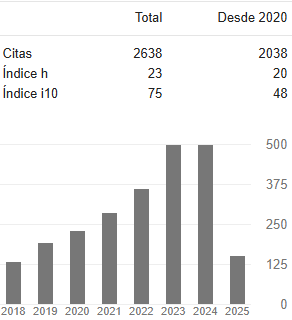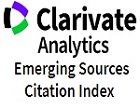Gamificación de una prueba psicológica para la evaluación del autocontrol en estudiantes con el sensor Kinect
DOI:
https://doi.org/10.31908/19098367.384Palabras clave:
Interacción Humano-Computador, Gamificación, Videojuegos serios, Autocontrol, Iowa Gambling Task, Toma de decisiones, Prueba psicológicaResumen
La tecnología de reconocimiento de gestos y movimiento puede soportar y mejorar las mediciones de constructos psicológicos como el autocontrol, el cual es considerado como un rasgo de personalidad o una habilidad para preferir consecuencias demoradas. Tradicionalmente, la evaluación es realizada con encuestas y la ejecución de tareas específicas. En este estudio el autocontrol fue medido con la prueba 16 PF y el patrón de elección fue evaluado con los diferentes valores de respuesta del Iowa Gambling Task. Una muestra de 85 estudiantes de psicología jugaron en una interfaz de humano-computador usando el sensor Kinect. Se encontró que los participantes tuvieron similares ganancias y un tiempo de reacción diferente (F (2, 8049) = 3.058, p < .005) y al tomar decisiones de jugar o pasar (p < .001) particularmente entre quienes puntuaron bajo y medio autocontrol. Estos hallazgos indican que el uso del sensor Kinect es útil para mejorar la tecnología para clasificar la ejecución de elecciones correspondientes a conceptos psicológicos.
Descargas
Referencias
B. F. Skinner and M. J. Gallofré, Ciencia y conducta humana: Fontanella Barcelona, 1974.
H. Rachlin, “Self-control: Beyond commitment,” Behavioral and Brain Sciences, vol. 18, pp. 109-121, 1995.
S. Piana, A. Staglianò, A. Camurri, and F. Odone, “A set of FullBody Movement Features for Emotion Recognition to Help Children affected by Autism Spectrum Condition,” in IDGEI International Workshop, 2013.
H. C. Miller, K. F. Pattison, C. N. DeWall, R. Rayburn-Reeves, and T. R. Zentall, “Self-control without a “self”? Common self-control processes in humans and dogs,” Psychological Science, 2010.
R. J. Huntjens, M. M. Rijkeboer, A. Krakau, and P. J. de Jong, “Implicit versus explicit measures of self-concept of self-control and their differential predictive power for spontaneous trait-relevant behaviors,” Journal of behavior therapy and experimental psychiatry, vol. 45, pp. 1-7, 2014.
A. P. Association, Diagnostic and statistical manual of mental disorders (DSM-5®): American Psychiatric Pub, 2013.
J. M. Low, D. Williamson, and J. Cottingham, “Predictors of university student lawbreaking behaviors,” Journal of College Student Development, vol. 45, pp. 535-548, 2004.
B. A. Schouten, R. Tieben, A. van de Ven, and D. W. Schouten, “Human behavior analysis in ambient gaming and playful interaction,” in Computer Analysis of Human Behavior, ed: Springer, 2011, pp. 387- 403.
R. Cialdini, “The science of persuasion,” Scientific American, vol. 284, p. 7, 2003.
B. Fogg, Persuasive Technology: Using Computers to Change what We Think and Do. Boston: Morgan Kaufmann, 2003.
Y. Liu, T. Alexandrova, and T. Nakajima, “Gamifying intelligent environments,” in Proceedings of the 2011 international ACM workshop on Ubiquitous meta user interfaces, 2011, pp. 7-12.
L. E. Nacke, “An introduction to physiological player metrics for evaluating games,” in Game Analytics, ed: Springer, 2013, pp. 585- 619.
T. Baranowski, R. Buday, D. Thompson, E. J. Lyons, A. S. Lu, and J. Baranowski, “Developing games for health behavior change: Getting started,” GAMES FOR HEALTH: Research, Development, and Clinical Applications, vol. 2, pp. 183-190, 2013.
R. Malaka, “How Computer Games Can Improve Your Health and Fitness,” in Games for Training, Education, Health and Sports, ed: Springer, 2014, pp. 1-7.
A. B. Fagundo, J. J. Santamaría, L. Forcano, C. Giner‐Bartolomé, S. Jiménez‐Murcia, I. Sánchez, et al., “Video Game Therapy for Emotional Regulation and Impulsivity Control in a Series of Treated Cases with Bulimia Nervosa,” European Eating Disorders Review, vol. 21, pp. 493-499, 2013.
M. N. K. Boulos, S. Wheeler, C. Tavares, and R. Jones, “How smartphones are changing the face of mobile and participatory healthcare: an overview, with example from eCAALYX,” BioMedical Engineering OnLine, vol. 10, pp. 24-24, 04/05
M. D. J. McNeill, D. K. Charles, J. W. Burke, J. H. Crosbie, and S. M. McDonough, “Evaluating user experiences in rehabilitation games,” Journal of Assistive Technologies, vol. 6, pp. 173-181, // 2012.
A. E. Staiano and S. L. Calvert, “Exergames for Physical Education Courses: Physical, Social, and Cognitive Benefits,” Child Development Perspectives, vol. 5, pp. 93-98, 2011.
H. Kharrazi, A. S. Lu, F. Gharghabi, and W. Coleman, “A Scoping Review of Health Game Research: Past, Present, and Future,” Games for Health Journal, vol. 1, pp. 153-164, 2012/04/01 2012.
E. Rahmani and S. A. Boren, “Videogames and Health Improvement: A Literature Review of Randomized Controlled Trials,” Games for Health Journal, vol. 1, pp. 331-341, 2012/10/01 2012.
H. Oinas-Kukkonen, “Behavior Change Support Systems: A Research Model and Agenda,” in Persuasive Technology: 5th International Conference, PERSUASIVE 2010, Copenhagen, Denmark, June 7-10, 2010. Proceedings, T. Ploug, P. Hasle, and H. Oinas-Kukkonen, Eds., ed Berlin, Heidelberg: Springer Berlin Heidelberg, 2010, pp. 4-14.
L. Obando and F. Parrado, “Aproximaciones conductuales de primera, segunda y tercera generación frente a un caso de ludopatía,” Revista Iberoamericana de Psicología: Ciencia y Tecnología, vol. 8, pp. 51- 61, 2015.
C. Bosch, J. Miranda, M. Sangiorgio, I. Acuña, Y. Michelini, L. Marengo, et al., “Efecto del entrenamiento con un juego de estrategia en tiempo real sobre la toma de decisiones en adolescentes,” PSIENCIA. Revista Latinoamericana de Ciencia Psicológica, vol. 8, p. 19, 2016.
A. I. Ferreira, L. F. Martínez, and M. A. Guisande, “Comportamiento de riesgo, rasgos de personalidad y accidentes de carretera en estudiantes universitarios,” 2015, vol. 2, 2015-10-29 2015.
A. Adan, “Impulsividad funcional y disfuncional en jóvenes con consumo intensivo de alcohol (binge drinking),” Adicciones, vol. 24, pp. 17-22, 2012.
A. L. Duckworth and S. M. Carlson, “Self-regulation and school success,” Self-regulation and autonomy: Social and developmental dimensions of human conduct, vol. 40, p. 208, 2013.
S. Newsome, A. L. Day, and V. M. Catano, “Assessing the predictive validity of emotional intelligence,” Personality and Individual Differences, vol. 29, pp. 1005-1016, 2000.
R. Shao, J. Read, T. E. J. Behrens, and R. D. Rogers, “Shifts in reinforcement signalling while playing slot-machines as a function of prior experience and impulsivity,” Transl Psychiatry, vol. 3, p. e213, 01/15/online 2013.
C. Anderson-Hanley, P. J. Arciero, N. Barcelos, J. Nimon, T. Rocha, M. Thurin, et al., “Executive function and self-regulated exergaming adherence among older adults,” Frontiers in human neuroscience, vol. 8, 2014.
R. Kulman, G. Stoner, L. Ruffolo, S. Marshall, J. Slater, and A. Dyl, “Teaching executive functions, self-management, and ethical decision-making through popular videogame play,” 2010.
S. Palacio, J. Villa, F. Parrado, and M. Rosero, “Modulación estrogénica de la toma de decisiones arriesgadas,” Textos y Sentidos, vol. 10, pp. 175-193, 2014.
M. Buelow and J. Suhr, “Construct Validity of the Iowa Gambling Task,” Neuropsychology Review, vol. 19, pp. 102-114, 2009/03/01 2009.
E. Cauffman, E. P. Shulman, L. Steinberg, E. Claus, M. T. Banich, S. Graham, et al., “Age differences in affective decision making as indexed by performance on the Iowa Gambling Task,” Developmental psychology, vol. 46, p. 193, 2010.
R. Van den Bos, W. Lasthuis, E. Den Heijer, J. Van der Harst, and B. Spruijt, “Toward a rodent model of the Iowa gambling task,” Behavior research methods, vol. 38, pp. 470-478, 2006.
B. Lange, C. Y. Chang, E. Suma, B. Newman, A. S. Rizzo, and M. Bolas, “Development and evaluation of low cost game-based balance rehabilitation tool using the microsoft kinect sensor,” in 2011 Annual International Conference of the IEEE Engineering in Medicine and Biology Society, 2011, pp. 1831-1834.
B. Lange, A. Rizzo, C.-Y. Chang, E. A. Suma, and M. Bolas, “Markerless full body tracking: Depth-sensing technology within virtual environments.”
S. Escalera, “Human behavior analysis from depth maps,” in Articulated Motion and Deformable Objects, ed: Springer, 2012, pp. 282-292.
E. A. Suma, D. M. Krum, B. Lange, S. Koenig, A. Rizzo, and M. Bolas, “Adapting user interfaces for gestural interaction with the flexible action and articulated skeleton toolkit,” Computers & Graphics, vol. 37, pp. 193-201, 2013.
R. B. Cattell and H. E. P. Cattell, “Personality Structure and the New Fifth Edition of the 16PF,” Educational and Psychological Measurement, vol. 55, pp. 926-937, 1995.
A. Aluja and A. Blanch, “Análisis descriptivo y comparativo del 16PF-5 en muestras americanas y españolas,” Boletín de Psicología (Valencia), pp. 27-38, 2002.
H. Fukui, T. Murai, H. Fukuyama, T. Hayashi, and T. Hanakawa, “Functional activity related to risk anticipation during performance of the Iowa Gambling Task,” Neuroimage, vol. 24, pp. 253-259, 2005.
M. Kleiner, “Visual stimulus timing precision in Psychtoolbox-3: Tests, pitfalls and solutions,” Perception ECVP abstract, vol. 39, pp. 189-189, 2010.
E. A. Suma, B. Lange, A. Rizzo, D. M. Krum, and M. Bolas, “Faast: The flexible action and articulated skeleton toolkit,” in Virtual Reality Conference (VR), 2011 IEEE, 2011, pp. 247-248.
C. J. Seeley, R. J. Beninger, and C. T. Smith, “Post Learning Sleep Improves Cognitive-Emotional Decision-Making: Evidence for a ‘Deck B Sleep Effect’ in the Iowa Gambling Task,” PLoS ONE, vol. 9, p. e112056, 2014.
W. H. Overman and A. Pierce, “Iowa Gambling Task with non-clinical participants: effects of using real + virtual cards and additional trials,” Frontiers in Psychology, vol. 4, p. 935, 12/12 08/06/received 11/26/accepted 2013.
D. J. Upton, A. J. Bishara, W.-Y. Ahn, and J. C. Stout, “Propensity for risk taking and trait impulsivity in the Iowa Gambling Task,” Personality and Individual Differences, vol. 50, pp. 492-495, 4// 2011.
M. T. Buelow and J. A. Suhr, “Personality characteristics and state mood influence individual deck selections on the Iowa Gambling Task,” Personality and Individual Differences, vol. 54, pp. 593-597, 4// 2013.
E. B. Larson, M. Feigon, P. Gagliardo, and A. Y. Dvorkin, “Virtual reality and cognitive rehabilitation: A review of current outcome research,” NeuroRehabilitation, 2014.
T. Baranowski, R. Buday, D. I. Thompson, and J. Baranowski, “Playing for real: video games and stories for health-related behavior change,” American journal of preventive medicine, vol. 34, pp. 74-82. e10, 2008.
J. P. Tangney, R. F. Baumeister, and A. L. Boone, “High self‐ control predicts good adjustment, less pathology, better grades, and interpersonal success,” Journal of personality, vol. 72, pp. 271-324, 2004.
T. Nakajima and V. Lehdonvirta, “Designing motivation using persuasive ambient mirrors,” Personal and ubiquitous computing, vol. 17, pp. 107-126, 2013.
D. Kahneman, “Thinking,” Fast and Slow, Farrar, Straus and Giroux, 2011.
G. Gigerenzer, Gut feelings: The intelligence of the unconscious: Penguin, 2007.
B. Fogg and J. Hreha, “Behavior wizard: A method for matching target behaviors with solutions,” in Persuasive Technology, ed: Springer, 2010, pp. 117-131.
G. M. Rodríguez, G. A. García, D. M. Gutiérrez, F. V. Pérez, and Z. C. Bohórquez, “[Competence between propioceptive and exteroceptive conditional stimuli in a conditional discrimination task],” Psicothema, vol. 21, pp. 390-396, 2009.
U. R. Karmarkar and Z. L. Tormala, “Believe me, I have no idea what I’m talking about: The effects of source certainty on consumer involvement and persuasion,” Journal of Consumer Research, vol. 36, pp. 1033-1049, 2010.
M. Martínez-Zarzuela, F. Díaz-Pernas, A. Tejeros-de-Pablos, D. González-Ortega, and M. Antón-Rodríguez, “Action recognition system based on human body tracking with depth images,” Advances in Computer Science: an International Journal, vol. 3, pp. 115-123, 2014.
W. R. Boot, M. Champion, D. P. Blakely, T. Wright, D. J. Souders, and N. Charness, “Video games as a means to reduce age-related cognitive decline: attitudes, compliance, and effectiveness,” Frontiers in psychology, vol. 4, 2013.
R. Angulo-Barroso, A. Busquets Faciabén, and E. MauerbergdeCastro, “El retrato de fase como una herramienta de análisis del comportamiento motor,” Apunts. Educación física y deportes, pp. 49- 61, 2010.
R. Bartlett, Introduction to sports biomechanics: Analysing human movement patterns: Routledge, 2007.
Descargas
Publicado
Número
Sección
Licencia
Derechos de autor 2019 Entre Ciencia e Ingeniería

Esta obra está bajo una licencia internacional Creative Commons Atribución-NoComercial 4.0.



















